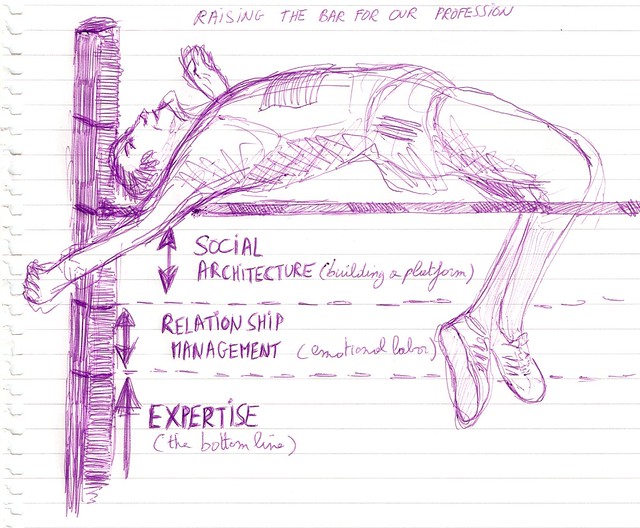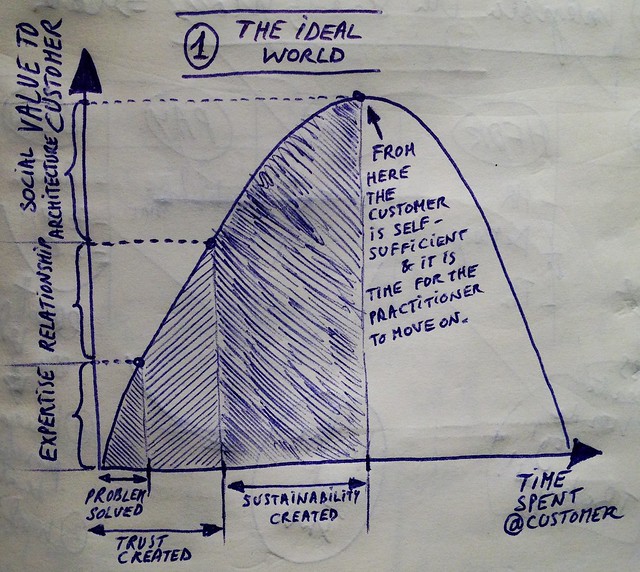This is the first part of a three-part series in which I am searching for the ideal point in time when it is time to end a consulting engagement.
A lot has been written about selling, managing resistance and delivering services, but ending an engagement and knowing when to end it seems to be a blind spot. In this series I will be shedding some light on that.
I am convinced that the conversation about when it is time for an organizational change practitioner to leave the customer should be part of the contracting phase. Having this conversation before the engagement starts brings candor and honesty to the customer relationship. In other words: it’s a deposit on the emotional bank account of trust.
Remember the specific way I look at our profession. From my perspective our job isn’t done when we delivered our expertise; that’s just the entry ticket. Our real goal is to develop a community around the project, that ensures that the technical architecture of the project can sustain and further develop. This is called Social Architecture and it calls for raising the bar for our profession in three levels: expertise, relationship management and Social Architecture.
An important thing to note is that we always have choice in how we deploy our services; we can either be an expert, or we can evolve to be a social architect.
- Experts don’t need strong relationships in order to just deliver their expertise. A good account manager will do. No trust is needed in that case; agreement on some basic elements is enough. This is the path of least resistance, because in this case, being right suffices to get the job done.
- On the other hand, for organizational change practitioners who aim to leave behind a Social Architecture, relationship management is quintessential in order to develop a community. Strange enough, Social Architecture is the road less traveled, because it demands being in relationship and being vulnerable in the first place.
On the graph below I have plotted these three levels on a scale of value we deliver to a customer during the life-cycle of an engagement.
- The first thing you will note is that this value curve is bell-shaped; i.e.: our value increases up to a certain level, after which it decreases at approximately the same pace.
- Secondly, the surfaces on the graph represent the value we bring to the customer in that specific period in time
- Thirdly – and most importantly – I am making the assumption of an ideal world, i.e.:
- Practitioners whose goal it is to leave behind a Social Architecture
- Practitioners who discussed this upfront with the customer
- Practitioners who designed the implementation path of the project to include the development of a community around the delivery
When we look at the curve from the theoretical perspective of an ideal world, we can see that very little time is needed to deliver a solution, compared to the time it takes to build a community. On the other hand, during that last phase the true value for the customer starts to appear.
At the top of the curve, basically your goal as an organizational change practitioner is accomplished: the customer is capable of continuing without you. However, just like learning to drive a car for the first time, the customer may feel a lot better when you are still around for some time. But soon enough it will be time to discuss your departure.
Extra bonus: Engaging in this conversation upfront will make it easier to re-contract or to prepare ourselves and our customer for a succesful ending of the engagement.
In the next post I will explore what this curve looks like in the majority of projects where teams are strictly focusing on delivery and no attention is spent on Social Architecture. Then, in the third and last post, we will explore the conciliation of the ideal world and what usually happens.
Series Navigation
When is it Time to Go? (Part 2) >>



Pingback: When is it Time to Go? (Part 2) | Reply-MC()
Pingback: When is it Time to Go? (Part 3) | Reply-MC()